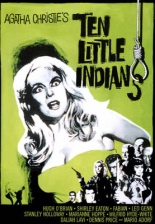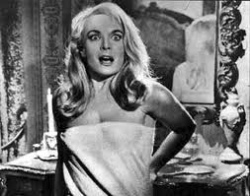
 Agatha Christie’s classic novel And Then There Were None has been adapted for the screen many times, but none more swingin’ than schlockmeister Harry Alan Towers’ 1965 production, Ten Little Indians. This version is inferior to the first and best, 1945’s And Then There Were None, directed by René Clair, but don’t let that dissuade you.
Agatha Christie’s classic novel And Then There Were None has been adapted for the screen many times, but none more swingin’ than schlockmeister Harry Alan Towers’ 1965 production, Ten Little Indians. This version is inferior to the first and best, 1945’s And Then There Were None, directed by René Clair, but don’t let that dissuade you.
Christie’s amazingly influential premise is directly ported onto screen as 10 strangers — a doctor, a judge, an actress, a singer, etc. — are summoned to a weekend in the mountaintop mansion of one Mr. U.N. Owen, a host none of them know. They’re awaiting his arrival when a recording of his voice (a disembodied Christopher Lee) accuses each of them of having commited murder of an innocent. Their punishment is getting murdered in turn, as they’re trapped in the estate until Monday.
 Not long after they notice the presence of the “Ten Little Indians” nursery rhyme all over the rooms, one of them dies, and in the exact manner as the rhyme’s first couplet. Just who is this Mr. Owen? Why is he doing this? And will they be able to find out before there are none of them left? You’ll have a ball being stumped.
Not long after they notice the presence of the “Ten Little Indians” nursery rhyme all over the rooms, one of them dies, and in the exact manner as the rhyme’s first couplet. Just who is this Mr. Owen? Why is he doing this? And will they be able to find out before there are none of them left? You’ll have a ball being stumped.
Only in the ’60s would teen idol Fabian be cast, making some of the strangest facial expressions the screen wouldn’t see the likes of until Daniel Day-Lewis in My Left Foot. Only in the ’60s would the lead roles be given to featherweight actors like Hugh O’Brian and former Bond girl Shirley Eaton (who, however, disrobes twice). And only in the ’60s would it be given a William Castle-esque gimmick in the form of a “Whodunit Break,” a minute-long intermission during which a clock countdowns the seconds, shows you clues and invites you to figure out the solution beforehand. —Rod Lott
